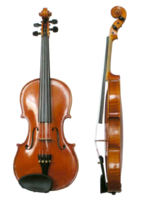
Photo from wikipedia
Wolfgang Amadeus Mozart was a piano prodigy from early childhood, but he was also an accomplished violinist. The instrument that his father bought him still exists, kept by the Mozarteum… Click to show full abstract
Wolfgang Amadeus Mozart was a piano prodigy from early childhood, but he was also an accomplished violinist. The instrument that his father bought him still exists, kept by the Mozarteum Foundation in Salzburg. It’s a fine instrument, made by the Klotz family of Bavarian violin-makers. But when Christoph Koncz, violinist with the Vienna Philharmonic, was granted permission recently to perform with it, he found that after such a long time of disuse “its sound had fallen asleep.” “At first its wood was stiff and it lacked resonance”, says Koncz. “Each time I played it, its sound opened up and the wood was in harmony again.” By the time Koncz was playing it in public and using it to record Mozart’s violin concertos, it had attained “a focused, very silky, silvery tone.” But how? Koncz attributes the change of tone to the instrument’s material: the wood needed “loosening” somehow to make it sing. Yet although the need for a ‘playing in’ period for any violin new to the musician is well attested, no one seems to know what it entails. “As yet no one has been able to explain what is involved in such a process”, says physicist Colin Gough of the University of Birmingham, an expert in violin acoustics. It’s likely to be at least partly a perceptual issue. “Top players often say that it can take them as long as a year to coax the kinds of sound they want out of instrument. Almost certainly this involves the brain becoming familiar with the sound of the instrument, and the development of the very subtle skills used by top performers in achieving the optimum sound.” “The phenomenon is well-known in the sense of folklore among players and makers”, says Jim Woodhouse, a mechanical engineer at the University of Cambridge. “Whether it is a physical phenomenon is more tricky: evidence is divided.” “Until now, there have never been any convincing physical measurements on instruments as they are being played in”, says Gough. Some violin-makers and restorers use mechanical shaking devices that claim to induce this playing-in effect artificially. Woodhouse says he and a student once made acoustic measurements with such a device — with mixed results. “We saw something change the first time we used it on our test instrument. But then we deliberately induced the kind of changes that are claimed to produce a need for further playing-in, and we never saw any change on subsequent occasions.” There seems no doubt that the tone of an instrument improves as the player gets to know it — but is any of that due to changes in the acoustic properties of the materials? One study found decreased internal damping after mechanical excitation in samples of violin wood (spruce)1. But while some investigations of prolonged mechanical vibration produced improvements in violin tone as judged by listeners and players2,3 and measurable changes in vibro-acoustic properties2,4, others found no measurable mechanical change in violin wood after such treatment5. One particularly careful study looked at two instruments made from the same wood (with a spruce top-plate), conducting expert blind listening tests after one had been played regularly for three years and the other hardly at all6. No significant differences in tone were identified. By what mechanism could playing cause material changes in the instrument anyway? That’s been little studied, but Woodhouse thinks it is possible that vigorous vibrations could relax residual stresses around important contact points that rely on friction: string notches, bridge feet, and the ends of the soundpost. Or — just possibly — traditional gelatine glue may creep a little to relieve stresses. Chemist Hwan-Ching Tai of the National Taiwan University has another suggestion: that stress-induced deformations will redistribute water molecules in the wood. “Although precise measurements are difficult, it is not far-fetched to attribute the awakening of old instruments to these factors”, he says. He believes there could also be age-related changes in the wood cellulose, which would be seen also in ancient Chinese stringed instruments called guqin. His team’s preliminary data show cellulose rearrangements in such instruments, probed by small-angle X-ray scattering with synchrotron radiation, caused either by age or by artificial treatment during manufacture. Vibration-induced redistribution of water was proposed to explain earlier observations of a change in damping after vibration1 — interestingly, this seems to make the wood stiffer with playing, contra Koncz’s subjective impressions. Tai hopes it might be possible to use techniques such as neutron scattering to probe stress-induced microscopic redistribution of water explicitly. That would be a worthy project. Whether anyone would consent to placing Mozart’s priceless instrument in a neutron beam is another matter. ❐
Journal Title: Nature Materials
Year Published: 2020
Link to full text (if available)
Share on Social Media: Sign Up to like & get
recommendations!